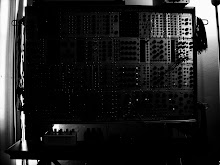For a few months I'd been hearing on and off on the forums (I make it sound like I actually go to more places than Muff Wigglers, which I don't) about Suit & Tie Guy's modules. Always a positive response. Some with more enthusiasm towards their praise than others, but mainly all positive non-the-less.
Always being the child who wanted to do as the cool kids do of course I had to find out for myself...
Having owned both an Arp 2600 and Odyssey I was hoping for something to remind me of those days, and for that it did not disappoint. I was able to revisit those sounds within a close enough distance to relive that feeling of squirting blippy S&H tantrums at random as well as match its growl decently for my taste. But, as always; individual user experiences may differ.
Trying for an Arp 2600 style S&H w/ spring reverb.
Sweeping the frequency of the cutoff with a little FM from the same oscillator.
The module was confusing to me at first. I wasn't getting sounds I expected it to make right away and I dismissed it as a bad module. (a typical scenario for modular owners. NONE ARE IMUNE!) But after stepping back and actually using my brain I found this module to be very fun. Its not a set and forget unit, oh no. This unit wants voltage and it wants its constantly. The offset makes for wonderful tonal shifts when running outputs from your audio interfaces such as a drum loop or what have you. I spent a good portion on the evening trying out different combinations on source input, knob settings and CV choices.
I would recommend these modules to any euro-rack, frac-rack user, or MOTM user. since they are available in all three formats.
I love the look of his Frac layouts. Being a stickler for asthetics I could go on about his 14HP eurorack module size or the colorful knob selections but these are really petty arguments when it comes down to it. I am not regretful for purchasing these units and look forward to his future releases.

